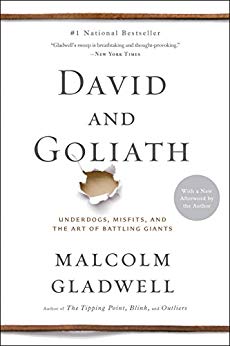

This article is an excerpt from the Shortform summary of "David and Goliath" by Malcolm Gladwell. Shortform has the world's best summaries of books you should be reading.
Like this article? Sign up for a free trial here .
Is more of something good always better? The inverted-U graph says no, not always.
An inverted-U graph is a curve that models the point at which something “good,” like money or effort, starts to make a situation worse.
Learn why it’s useful in predicting the point at which you might have too much of a good thing.
The Advantages of Having Less Than Your Opponent
Most of us tend to believe that when something is good (like strength, money, or small class sizes), more of it is better. But Goliath’s abundance of size, strength, and weaponry didn’t protect him from David’s rock–it made him more vulnerable. There is a point at which the accumulation of resources ceases to be an advantage and another point at which those resources become a distinct disadvantage. The visual representation of this theory is the inverted-U graph.
The Inverted-U Graph
When you graph the relationship between, say, parenting success and money (an example we’ll explore more below), the shape is an upside-down U.
The tendency of graphs toward an inverted-U shape shows us that many things we think of as unequivocally advantageous, like money or material resources, aren’t. Nothing is good, evil, or even neutral. An item’s value often depends on how much of it you have. It’s advantageous until you have so much of it that its value becomes neutral. At the point of overabundance, its value goes from neutral to negative. What was an advantage in a limited amount becomes a disadvantage in a large amount.
Let’s see how this plays out in an example.
Inverted-U Graph Example: Money and Parenting
Picture the inverted-U graph. If the X-axis is wealth and the Y-axis is the “easiness” of parenting (0 being not easy at all), poverty is located at the bottom left of the curve. If you live in poverty, it’s harder to be a good parent. Spending long hours at a demanding job is exhausting and leaves you little time or energy to spend with your children.
An increase in money makes parenting easier…to a certain point. Then the benefits start to diminish in proportion to wealth.
Perhaps surprisingly, there’s a point at which the wealthier you are, the harder parenting is, and the curve makes its downward slope. Let’s look at the inverted-U graph:
Why would having a lot of money make parenting harder?
Let’s look at why the seemingly faulty logic of the inverted-U graph actually makes a lot of sense.
You probably want to raise kids who understand the value of hard work and the fulfillment it brings. If your child asks for a pony, and you don’t have the money for one, it’s relatively easy to say, “No, we can’t afford that.” It’s the truth, and there’s no decision to make: buying a pony is not an option.
On the other hand, if your child asks for a pony and you do have the money, you can’t use the excuse that you can’t afford it. Still, you don’t want to buy your daughter a pony—you want her to learn to work hard for what she wants, rather than depend on her parents to satisfy her every whim. But it’s much harder to say “I won’t buy you a pony” than “I can’t buy you a pony.” If you refuse to buy a pony (rather than being unable to), you have to explain to your child why you won’t buy it. To explain why, you have to have clear values (not always easy) and know how to communicate those values (also not easy). Additionally, you have to stay firm in the face of an upset child, no mean feat when you have the resources to make your child immediately (if momentarily) happy. This helps explain why the logic of the inverted-U graph rings true in this instance.
Anecdote: The Hollywood Power Player
One unnamed Hollywood power player is very aware of the logic of the inverted-U graph and how his wealth is a disadvantage for his children. He grew up in a lower-middle-class neighborhood in Minneapolis. If he wanted new shoes or a bike, he had to pay half, and to get the things he wanted he became an entrepreneur at age 10, paying neighborhood kids to shovel snow and rake leaves for residents. He worked throughout college, business school, and law school, and climbed his way up the ranks in Hollywood.
He attributes his success to the values he gained from growing up without financial means and working hard for everything he attained. Now a multimillionaire, he knows his children won’t have to work for what they want the way he did. He believes that his children will be less ambitious and won’t know the value of money or even their self-worth.
The inverted-U graph can represent many relationships. Knowing our lives often conform to its curve, remember that it’s possible to have too much of a good thing.
———End of Preview———

Like what you just read? Read the rest of the world's best summary of "David and Goliath" at Shortform . Learn the book's critical concepts in 20 minutes or less .
Here's what you'll find in our full David and Goliath summary :
- Why being the underdog can actually be an advantage
- Why you shouldn't be afraid of powerful giants
- Strategies to get an edge when you're overpowered






